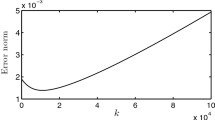Abstract
It is shown how, by analogy to analogue control theory, the problem of spectral factorization can be solved using negative feedback. The method is particularly simple to implement and can easily be used in real-time applications. It is shown how the method can blindly identify or track the moving-average (MA) model of a signal generating process using only second-order statistics.
Similar content being viewed by others
References
A. Ahlen, M. Sternad, Wiener filter design using polynomial equations. IEEE Trans. Signal Process. 39(11), 2387–2399 (1991)
J.F. Barrett, T.J. Moir, A unified approach to multivariable discrete-time filtering based on the Wiener-theory. Kybernetika 23(3), 177–197 (1987)
H. Boche, V. Pohl, Behaviour of the spectral factorization for continuous spectral densities. Signal Process. 87(5), 1078–1088 (2007)
C. Charoenlarpnopparut, One-dimensional and multidimensional spectral factorization using Gröbner basis approach, in APPC on Communications Bangkok (2007), pp. 201–204
F. Desbouvries, I. Fijalkow, P. Loubaton, On the identification of noisy MA models. IEEE Trans. Autom. Control 41(12), 1810–1814 (1996)
S. Fomel, P. Sava, J. Rickett, J. Claerbout, The Wilson-Burg method of spectral factorization with application to helical filtering. Geophys. Prospect. 51, 409–420 (2003)
M.J. Grimble, H infinity fixed-lag smoothing filter for scalar systems. IEEE Trans. Signal Process. 39(9), 1955–1963 (1991)
P. Hagander, B. Wittenmark, A self-tuning filter for fixed-lag smoothing. IEEE Trans. Inf. Theory 23(3), 377–384 (1977)
M.H. Hayes, Statistical Digital Signal Processing and Modelling (Wiley, New York, 1996)
S. Haykin, Adaptive Filter Theory (Prentice Hall, Englewood Cliffs, 1986)
A.N. Kolmogorov, Stationary sequences in Hilbert space. Bull. Moscow State Univ. 2(6), 1–40 (1941). English Trans. in Linear Least Squares Estimation, ed. by T. Kailath (Dowden, Hutchinson & Ross, Pennsylvania, 1977), pp. 66–89
V. Kucera, Discrete Linear Control, the Polynomial Equation Approach (Wiley, New York, 1991)
D.I. Laurenson, D.G.M. Cruickshank, G.J.R. Povey, A computationally efficient multipath channel simulator for the COST 207 models, in IEE Colloquium on Computer Modelling of Communication Systems (1994), pp. 8/1–8/6
L.M. Li, Li Factorization of moving-average spectral densities by state-space representations and stacking. J. Multivar. Anal. 96(2), 425–438 (2005)
T.J. Moir, Stabilizing discrete polynomials using spectral factorization. Electron. Lett. 27(7), 581–583 (1991)
T.J. Moir, Equivalence between state-space and polynomial methods for discrete LQG control. Syst. Sci. (Tech. Univ. Wroclaw) 20(4), 5–17 (1994)
T.J. Moir, Control theoretical approach to multivariable spectral factorisation problem. Electron. Lett. 45(24), 1215–1216 (2009)
T.J. Moir, J.F. Barrett, A Wiener-theory of digital linear-quadratic control. Int. J. Control 49(6), 2123–2155 (1989)
D. Napp Avelii, H.J. Trentelman, Algorithms for multidimensional spectral factorization next term and sum of squares. Linear Algebra Appl. 429(5–6), 1114–1134 (2008)
C. Oara, Constructive solutions to spectral and inner–outer factorizations with respect to the disk. Automatica 41(11), 1855–1866 (2005)
L. Parra, C. Spence, Convolutive blind separation of non-stationary sources. IEEE Trans. Speech Audio Process. 8(3), 320–327 (2000)
A.H. Sayed, T. Kailath, A survey of spectral factorization methods. Numer. Linear Algebra Appl. 8, 467–496 (2001)
A. Senjian, J.H. Manton, H. Yingbo, A sequential subspace method for blind identification of general FIR MIMO channels. IEEE Trans. Signal Process. 53(10), 3906–3910 (2005)
B. Taub, Implementing the Iakoubovski–Merino spectral factorization next term algorithm using state–space methods. Syst. Control Lett. 58(6), 445–451 (2009)
P. Welch, The use of fast Fourier transform for the estimation of power spectra: a method based on time averaging over short modified periodograms. IEEE Trans. Audio Electroacoust. 15(2), 70–73 (1967)
N. Wiener, Extrapolation, Interpolation and Smoothing of Stationary Time Series (Wiley, New York, 1949)
G. Wilson, Factorization of the covariance generating function of a pure moving-average process. SIAM J. Numer. Anal. 6, 1–7 (1969)
G.T. Wilson, The factorization of matricial spectral densities. SIAM J. Appl. Math. 23(4), 420–426 (1972)
D.C. Youla, On the factorization of rational matrices. IRE Trans. Inf. Theory IT-7, 172–189 (1961)
D.C. Youla, N. Kazanjian, Bauer-type factorization of positive matrices and the theory of matrix polynomials orthogonal on the unit circle. IEEE Trans. Circuits Syst. 25(2), 57–69 (1978)
Author information
Authors and Affiliations
Corresponding author
Rights and permissions
About this article
Cite this article
Moir, T.J. A Control Theoretical Approach to the Polynomial Spectral-Factorization Problem. Circuits Syst Signal Process 30, 987–998 (2011). https://doi.org/10.1007/s00034-011-9270-4
Received:
Revised:
Published:
Issue Date:
DOI: https://doi.org/10.1007/s00034-011-9270-4




